#constance charpentier
Explore tagged Tumblr posts
Text

Constance Charpentier, Melancholy (1801)
#art#artwork#fine art#painting#classical art#oil painting#classic art#paintings#gallery#detailed art#female painter#Constance Charpentier
7 notes
·
View notes
Quote
Georges has arrived. He asks for his dear Gabrielle. He kisses the sheets in which she died. He takes pleasure only in contemplating the sketch you have drawn. He looks for her features there, he finds them. I talk to him but he doesn’t answer. If you want to save him, if you want to save my family, remember the features of my adored sister, sketch them, take care only of her. We all urge you. We will repay you with eternal gratitude and the most tender attachment. Hearts such as ours cannot pay too much for such a blessing. V.F. Charpentier.
Letter from Danton’s brother-in-law Victor-François Charpentier to his soon to be wife Constance Charpentier, telling her about Georges’ reaction to his wife’s death. Cited in Constance Charpentier: Peintre (1767-1849) by Gildas Dacre-Wright, page 31
8 notes
·
View notes
Text
I wonder why Danton usually wears a red or brown coat in many films and illustrations, even though he wears a dark blue coat in both of the two portraits.
The painter Constance Charpentier, who painted at least one of the two portraits and was his sister-in-law, said that he looked so good in blue. She wrote in a letter to his children that's why she painted the amaranth (I searched and found a variety of colors ranging from purple to shocking pink, so I'm not sure what color it was exactly) jacket he originally wore in the portrait blue. However, I don't know if he actually had a navy blue coat or if she decided it would look good on him in her imagination.
I think the actors who played Danton, like Depardieu and Brandauer, would look better in warm colors than blue, so the cartoons and illustrations may be influenced by them. Still, it is strange that I don't see many Dantons wearing blue like in the portrait.
10 notes
·
View notes
Text
The stress of all the stuff I have left to do plus the submarine stuff plus the weather knocked me out today. I have so much to do and I’ve been feeling sick all day, so instead I came home, ate and took a nap. Not even going to Pilates even though I’ve been looking forward to it all week. I have so much to do. I have so much to do.

#dread.#🦪.txt#don’t worry I’ll pick myself up in a second#I just need to Constance Marie Charpentier for a Minute
12 notes
·
View notes
Text

Oil Painting, ca. 1790, French.
By Constance-Marie Charpentier.
Portraying Georges Danton in a black coat and white cravat.
Musée Carnavalet.
#georges danton#1790#1790s#1790s painting#1790s france#1790s menswear#french revolution#constitutional monarchy#black#coat#musée carnavalet#Constance-Marie charpentier#oil painting#France#French
5 notes
·
View notes
Photo

First attributed to Jacques-Louis David and then Constance Marie Charpentier, this compelling 1801 portrait is now believed to be the work of Marie-Denise Villers: https://publicdomainreview.org/collection/villers-portrait
189 notes
·
View notes
Photo

Melancholy by Constance Marie Charpentier 1801
1K notes
·
View notes
Text
I don't want people to reblog that AI art post so I'll put my addition here:

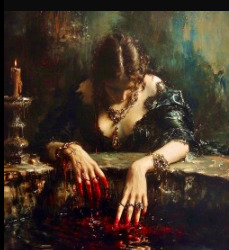
One thing that will always make me cringe with those AI imitations of middle to late 19th century art is how the intelligence will always try to match ALL the women figures with the current 21th century beauty standards. Now, of course, I wouldn't be complaining if these kind of images weren't plaguing the "classical art" or "oil painting" tags. But since they are, I will show you what 19th century painting of women really looks like. And yeah, I know, some paintings match with current beauty standards but it's still more complicated than that. "Classic" painting is not all about representing pretty ladies. Otherwise historians of art would be bored.
Okay, if it's a "classic" painting, let's go with neoclassicism which is basically a return to the classic inspirations from antiquity and a return to simplicity after years of the wild Baroque and Rococo of the 18th century. Want to see portraits of women in that time?
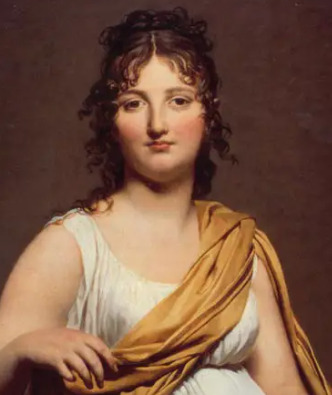

(Left : Detail of Portrait de madame de Verninac by Jacques-Louis David, 1979. Right : Portrait de Madame Duvaucey, 1809, Jean-Dominique Ingres).
So far, notice how these two women don't look at all like the women in those fake AI paintings. They are portraits of real women, thus real models. But even when they were painting gods, 19th century painters HAD models! Not only that, they were also inspired by antiquity, which wasn't really doing realism either, they had their own ideals like, to cite one exemple, the really straight noses you always see in greek statues. Well, that's also in neoclassical paintings! Look:
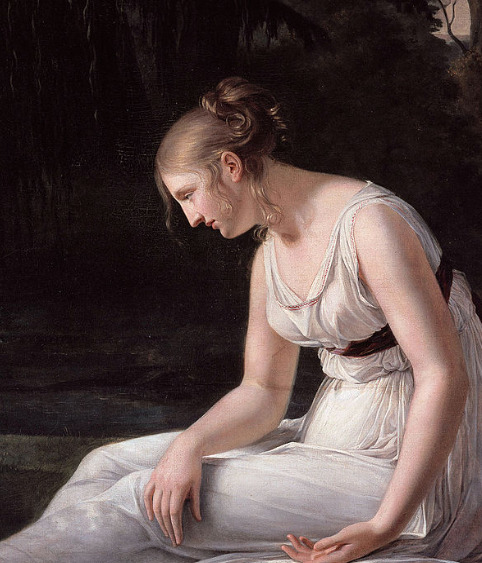
(Detail of La Mélancolie by Constance Marie Charpentier, 1801)
On the other side, you've got two strong opponents (and logical responding movements) to this return to classical culture : Romantism and Realism. Once again, look at the diversity :

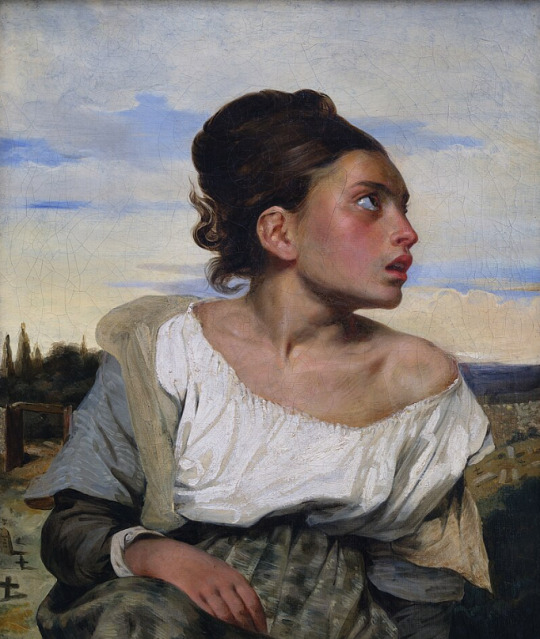
(Left: Details of Les foins by Jules Bastien-Lepage, 1877. Right: Jeune orpheline au cimetière, Eugène Delacroix, 1824.)
Realism is pretty self-explanatory. The painters were going back to show normal people, farmers and workers. They weren't here to make them beautiful or to conform to beauty standards but to show the world as it is. Result was a lot of controversies, notably with Courbet and Les baigneuses, a representation of a strong woman in an unflatering pose and dirt on her feet that shook the beauty standards so dear to the academic ideals of his times. Check it out if you're interested, there's plenty of articles about it. And romanticism? Once again very diverse. Just look at pre-romantism, with Goya, who loooved representing fucked up little scenes. Or with Delacroix, here with one of his most famous portrait (Jeune orpheline au cimetière) probably because of the expression, the pose, everything that makes that girl look alive, real, unique.
But wait.... You've already seen classical paintings were the ladies looked like all the ladies nowadays, right? Maybe you've seen those very pretty pre raphaelites paintings with those women that look kinda like Florence Welch. Maybe you've seen academic art, the most palatable of 19th century style when it comes to beauty norms. And it's true, it could be similar to these prompted AI classical babes, except once again, it's not. Because once again, they had models, and models were different from paintings to paintings. And this is this systematic same face vibes that makes AI so boring. Because even when real historical art comes close to that, it is always way way way more rich and full of surprises.


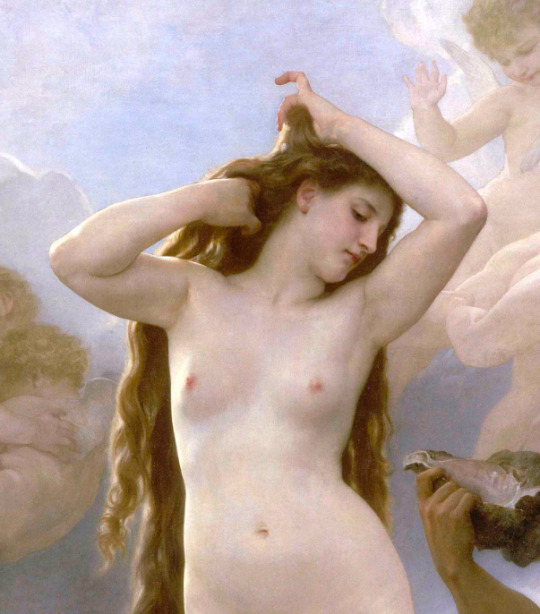
(left : The North-West Passage by John Everett Millais, 1878. Middle: Detail of Contemplation by John William Godward, 1922. Right: Detail of La Naissance de Vénus by William Bouguereau, 1879)
Then, you have all these art styles that AI weirdly stays away from : those where the style and process is so strong, so much more important than the subject, that it would be hard to copy without noticing the difference. It could be impressionism, it could be symbolism or better, it could be the avant-garde artists that announces then blends into the wild, colorful and tortured art of the first half of the 20th century.
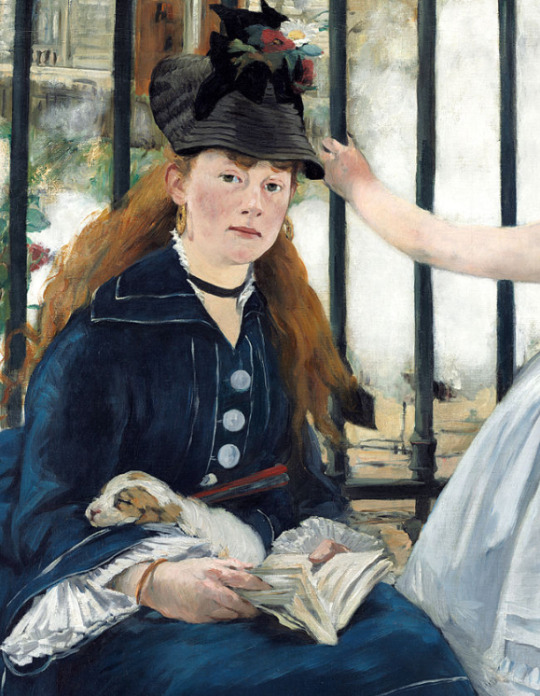
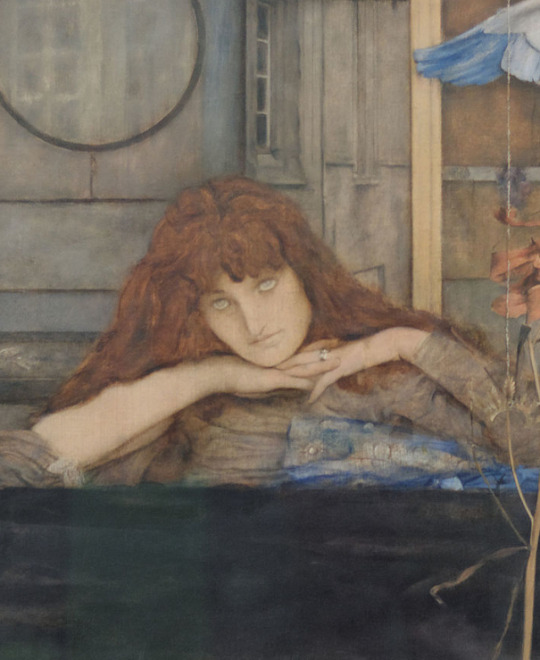
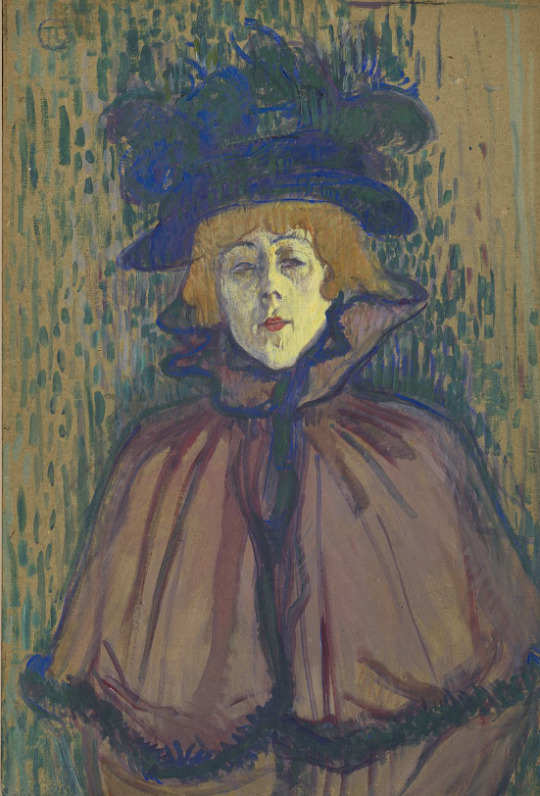
(Left: Le chemin de fer by Edouard Manet, 1973. Middle: I lock my door upon myself by Fernand Khnopff, 1891, Right: Jane Avril by Henri de Toulouse Lautrec, 1892)
Conclusion/ TLDR : If fake historical AI art becomes more realistic every day, it will never be as rich and diverse as the real deal because it will always be used to appease an algorithm for people who just want to see pretty images that catters to them and never challenge their views. When it comes to beauty norm, this could be dangerous and make people believe that these was always how women looked like. That all girls were born with removed buccal fat and symmetrical faces, even in old paintings. I don't know, it may be nothing, but it may be something. Thank you for those who read all that and I hope see many cool paintings in museums :)
Addition: This is of course a very european centric vision of art but it's what the AI will take inspiration from anyway. For the same reasons, these paintings are very white but I was also trying to avoid the icky orientalist representations that were so trendy in the 19th century. Note that there is an even better diversity in paintings when you open your eyes to non-european centric art.
(If I see a terf reblogging this, i'm blocking on sight)
124 notes
·
View notes
Text
My Raoul is a Composite Character
Musings on writing the Vicomte (Ensigne) de Chagny
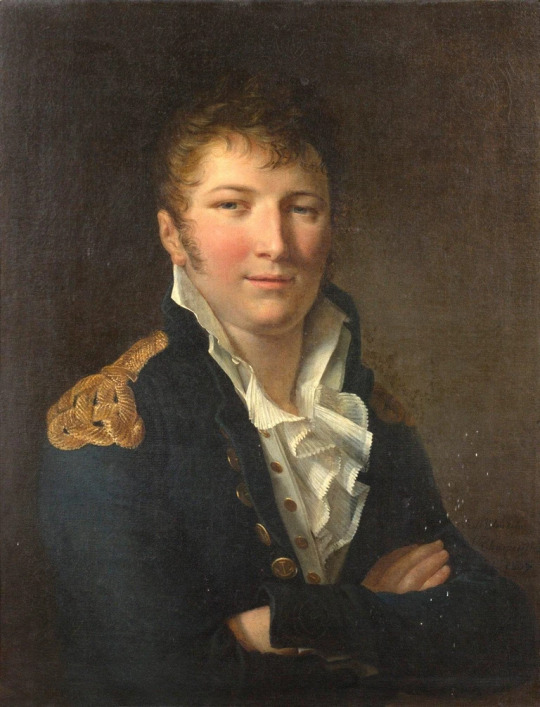
(Painting by Constance Marie Le Charpentier is from 1807; Raoul never would have worn this uniform but ... the attitude)
As All Vows is coming to an end, I first want to thank everyone for reading and for commenting and sharing your thoughts along the way. One of the most frequent comments is how I've really brought Raoul to life and made him sympathetic. This is great, because it's my intent, and also my next big longfic is all Raoul POV! I'm writing that one offline, with the plan to publish when complete. I have some other projects to be announced soon that will be on AO3 in installments. So watch this space.
Bringing Raoul to life has been natural because to me, he is alive. That's because my Raoul is a composite character of real people.
Even though I cosplay Christine, and Christine is the main character in All Vows, Raoul has accidentally gotten the most of myself. Some of his descriptions of being at sea are taken straight out of my journals from Ensign Flag's first deployment. I have plans for my "Raoul Navy" project for him to write absolutely horrific poetry about Christine's blue eyes (it was my bad poetry about some Marine corps pilot I had a crush on when I was...24)He's a composite character of dozens of young officers I've served with over the years. I have literally lived and worked (and sometimes loved) these young men, and later on, now that I am An Old, I'm their boss, mentoring them and developing them into leaders (and reminding them that their wife has probably already told them three times about the "scheduling surprise their wife just told them about").
So in all, my Raoul is a tribute to the best of them, and I'm fortunate that I get to tell their story.
POTOMER DAY 27: HEADCANON-My Raoul is a Composite Character
From April 23 -June 11, I am posting 49 days of POTO content to mark the Omer, except on Shabbat. Masterlist of prior posts.
#phantom of the opera#poto#raoul#the raoul navy#raoul navy#headcanon#fanfic writer#phantom#phanphic#raoul de chagny#amwriting#writer#wip#POTOMER#all vows#my fic
18 notes
·
View notes
Text
Female French Painters during the Napoleonic Era:
This is a short compilation to highlight some of the work of really awesome and overlooked female artists in France during the early 19th century and the late 18th century. There honestly were a lot of professional female painters during this time period due to more freedom of expression, and female artists were being celebrated and encouraged from the very top of French society.
Tumblr only allows a limited number of pictures in one post, so I shall be posting a lot more to continue sharing the beautiful artwork from women during this time.
Marie-Denise Villers

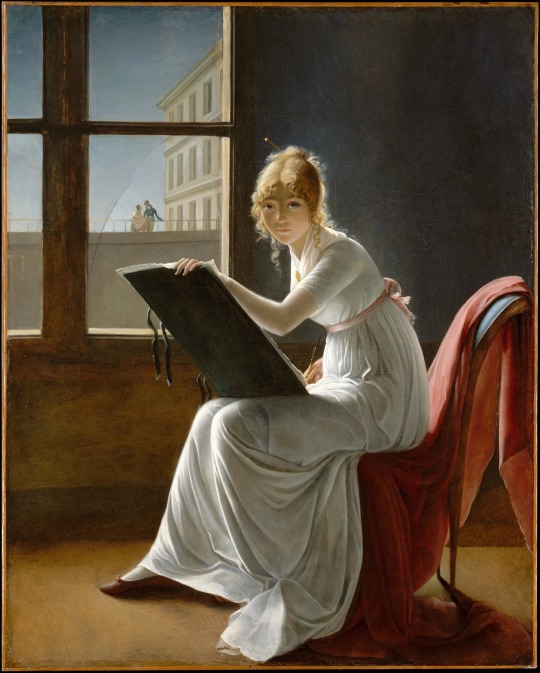
Une étude de femme d'après nature (Study of a Woman), 1802
Portrait of Marie Joséphine Charlotte du Val d'Ognes, 1801
Marie-Guillemine Benoist

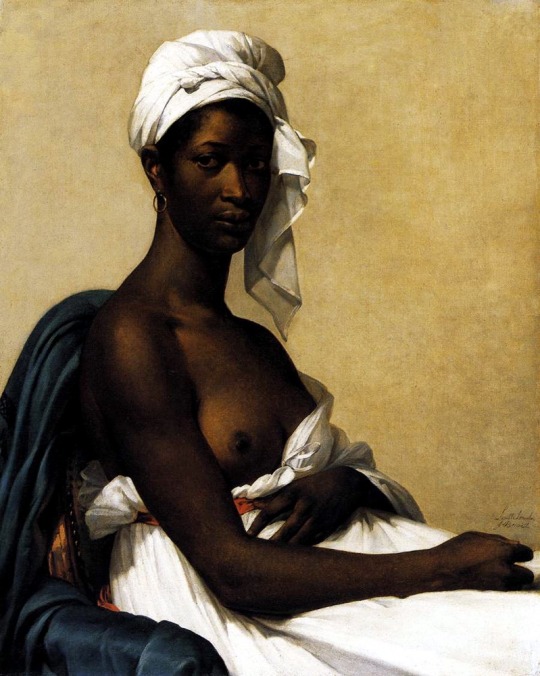
Pauline Bonaparte, Princesse Borghese, 1808
Portrait d'une femme noire (Portrait of Madeleine), 1800
Constance Marie Charpentier

Melancholy, 1801
Marguerite Gérard

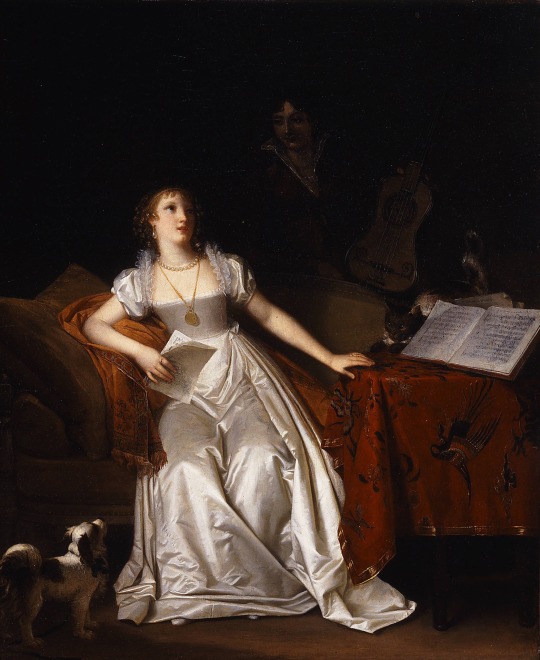
Motherhood, circa 1800s
Prelude to a Concert, 1810
Jeanne-Elisabeth Chaudet
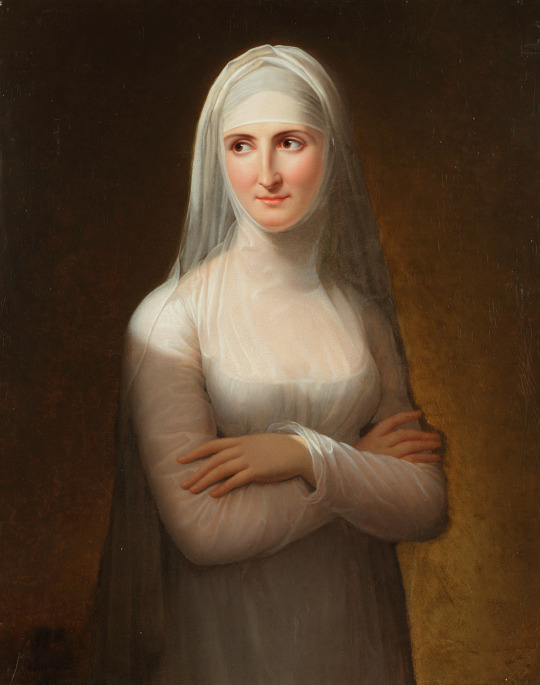

Portrait of a lady as a novice, 1811
Gustava and Wilhelmina Armfelt, 1802
Constance Mayer
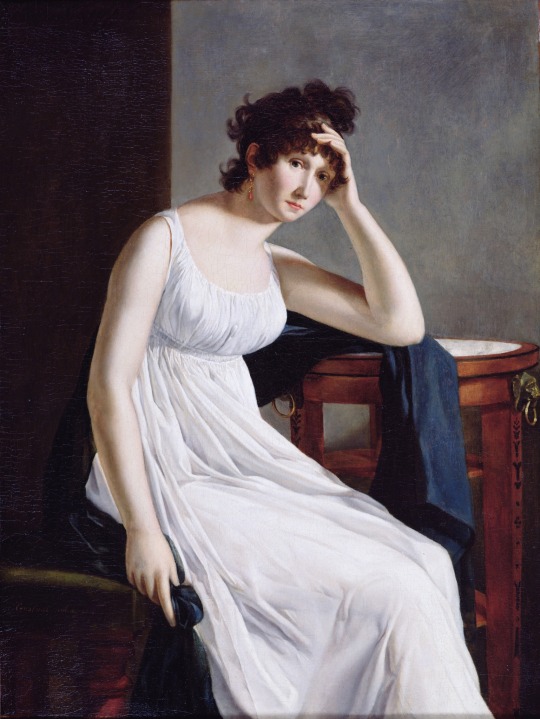
Self-portrait, 1801
#napoleonic era#empire period#female artist#women artists#female artists#women artist#female painter#women’s art#women#19th century#1800s#1800s art#19th century art#1810s#first french empire#french empire#the consulate and empire#napoleonic#French#France#woman#female#art#fashion#painting#portrait#empire#empire style#empire fashion#french art
97 notes
·
View notes
Text
One thing that will always make me cringe with those AI imitations of middle to late 19th century art is how the intelligence will always try to match ALL the women figures with the current 21th century beauty standards. Now, of course, I wouldn't be complaining if these kind of images weren't plaguing the "classical art" or "oil painting" tags. But since they are, I will show you what 19th century painting of women really looks like. And yeah, I know, some paintings match with current beauty standards but it's still more complicated than that. "Classic" painting is not all about representing pretty ladies. Otherwise historians of art would be bored.
Okay, if it's a "classic" painting, let's go with neoclassicism which is basically a return to the classic inspirations from antiquity and a return to simplicity after years of the wild Baroque and Rococo of the 18th century. Want to see portraits of women in that time?


(Left : Detail of Portrait de madame de Verninac by Jacques-Louis David, 1979. Right : Portrait de Madame Duvaucey, 1809, Jean-Dominique Ingres).
So far, notice how these two women don't look at all like the women in those fake AI paintings. They are portraits of real women, thus real models. But even when they were painting gods, 19th century painters HAD models! Not only that, they were also inspired by antiquity, which wasn't really doing realism either, they had their own ideals like, to cite one exemple, the really straight noses you always see in greek statues. Well, that's also in neoclassical paintings! Look:

(Detail of La Mélancolie by Constance Marie Charpentier, 1801)
On the other side, you've got two strong opponents (and logical responding movements) to this return to classical culture : Romantism and Realism. Once again, look at the diversity :


(Left: Details of Les foins by Jules Bastien-Lepage, 1877. Right: Jeune orpheline au cimetière, Eugène Delacroix, 1824.)
Realism is pretty self-explanatory. The painters were going back to show normal people, farmers and workers. They weren't here to make them beautiful or to conform to beauty standards but to show the world as it is. Result was a lot of controversies, notably with Courbet and Les baigneuses, a representation of a strong woman in an unflatering pose and dirt on her feet that shook the beauty standards so dear to the academic ideals of his times. Check it out if you're interested, there's plenty of articles about it. And romanticism? Once again very diverse. Just look at pre-romantism, with Goya, who loooved representing fucked up little scenes. Or with Delacroix, here with one of his most famous portrait (Jeune orpheline au cimetière) probably because of the expression, the pose, everything that makes that girl look alive, real, unique.
But wait.... You've already seen classical paintings were the ladies looked like all the ladies nowadays, right? Maybe you've seen those very pretty pre raphaelites paintings with those women that look kinda like Florence Welch. Maybe you've seen academic art, the most palatable of 19th century style when it comes to beauty norms. And it's true, it could be similar to these prompted AI classical babes, except once again, it's not. Because once again, they had models, and models were different from paintings to paintings. And this is this systematic same face vibes that makes AI so boring. Because even when real historical art comes close to that, it is always way way way more rich and full of surprises.



(left : The North-West Passage by John Everett Millais, 1878. Middle: Detail of Contemplation by John William Godward, 1922. Right: Detail of La Naissance de Vénus by William Bouguereau, 1879)
Then, you have all these art styles that AI weirdly stays away from : those where the style and process is so strong, so much more important than the subject, that it would be hard to copy without noticing the difference. It could be impressionism, it could be symbolism or better, it could be the avant-garde artists that announces then blends into the wild, colorful and tortured art of the first half of the 20th century.



(Left: Le chemin de fer by Edouard Manet, 1973. Middle: I lock my door upon myself by Fernand Khnopff, 1891, Right: Jane Avril by Henri de Toulouse Lautrec, 1892)
Conclusion/ TLDR : If fake historical AI art becomes more realistic every day, it will never be as rich and diverse as the real deal because it will always be used to appease an algorithm for people who just want to see pretty images that catters to them and never challenge their views. When it comes to beauty norm, this could be dangerous and make people believe that these was always how women looked like. That all girls were born with removed buccal fat and symmetrical faces, even in old paintings. I don't know, it may be nothing, but it may be something. Thank you for those who read all that and I hope see many cool paintings in museums :)
Addition: This is of course a very european centric vision of art but it's what the AI will take inspiration from anyway. For the same reasons, these paintings are very white but I was also trying to avoid the icky orientalist representations that were so trendy in the 19th century. Note that there is an even better diversity in paintings when you open your eyes to non-european centric art.
(If I see a terf reblogging this addition, i'm blocking on sight)

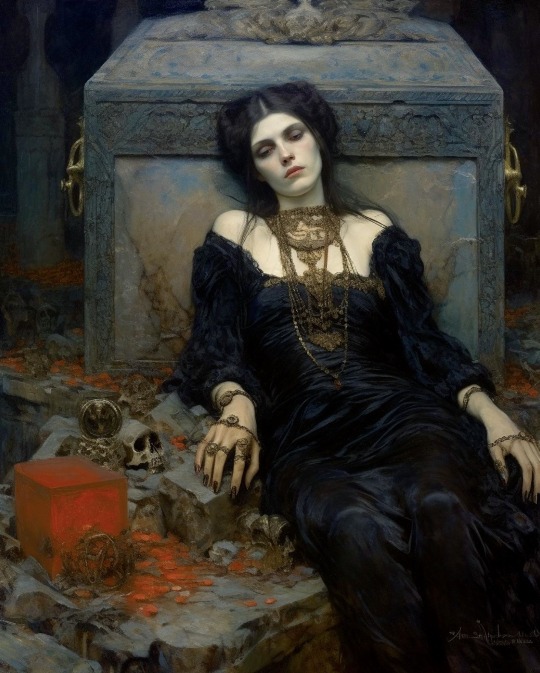

𝐕𝐚𝐦𝐩𝐢𝐫𝐞’𝐬 𝐂𝐫𝐲𝐩𝐭 †
— by The Phantom Painter
6K notes
·
View notes
Note
Do we know much about Gabrielle Danton???
I wouldn’t say that, like with Louise Sébastienne, we have no (published?) conserved letters written by or adressed to Gabs. Edit: here is actually a letter from Georges to Gabrielle from December 17 1792.
Antoinette Gabrielle Charpentier was born in Paris on January 6 1760 (wikipedia says she was born ”around 1762,” this is an error). Her parents were Angélique-Octavie Soldini and François-Jérôme Charpentier, the latter of which was the owner of a parisian café. Gabrielle also had two brothers, Antoine-François and François Victor, the latter of which would go on to marry Constance-Marie Bondelu, the painter behind the most famous portrait of Danton. Before her marriage, Gabrielle lived with parents on Quai de l’École, in the parish of Saint-Germain l’Auxerrois.
The wedding contract between Georges and Gabrielle was signed on June 9 1787, in the presense of many people. Gabrielle received a dowry of 20 000 pounds. Danton had earlier also borrowed 15 000 livres from his future father-in-law which he had used to buy a position as a lawyer at the King's Council.
Georges and Gabrielle had four children together:
François, who died eleven months old in Arcis on April 24 1789 and was buried there the following day.
Antoine, born June 18 1790, and baptised in Salt-Sulpice on the same day. According to Constance Charpentier: Peintre (1767-1849) – ”on leaving the church, Gabrielle hung a tricolor cockade on their son's baptismal robe and it is said that his father said his first words would be "Vivre libre ou mourir". But no source is cited for this claim. Antoine died in Arcis on June 14 1858.
François-Georges, born February 2 1792 and baptised in the church of Saint-André-des-Arts the same day. He was for a time sent to a wetnurse in l'Ile-Adam (On July 12 1792, Desmoulins wrote to his father: ”I named [my son] Horace Camille Desmoulins. He was immediately sent to a wetnurse in l'Ile-Adam (Seine-et-Oise ) with the little Danton.”) from which he was back from at least since August 1792. He died on June 18 1848.
Finally, an unnamed girl (most places say a boy, but this is again an error) born in early February 1793, who died not long after her birth. Gabrielle herself died around the same time.
The most personal aspects of Gabrielle’s life come from the pen of Lucile Desmoulins. In the incertainty that follows the flight to Varennes, she stays for a bit in Gabrielle’s apartment in order to not be alone, and in a letter to her mother dated June 24 1791, she writes:
Sometimes people came to tell us that we were lost, and when we were told good news, Madame Danton, her eyes filled with tears, threw herself around my neck.
(This part of the letter was cited in Camille et Lucile Desmoulins: un rêve de république (2019). The rest of it has unfortunately not been published, but maybe it includes more details regarding Gabrielle)
Gabrielle is also frequently mentioned in the diary Lucile kept 1792-1793, in which she’s simply known as ”mde d.” From the entry in which she first shows up — June 28 1792 — we learn that Gabrielle knew how to play some sort of musical intrument — ”madame Danton came over, we played music.” The next time Lucile mentions her is on July 5 — ”My head is spinning. I was madame Danton after dinner. (sic)” Decide for yourself if Lucile simply means ”I was with madame Danton after dinner”, or if she has been smoking some real shit.
Lucile also mentions Gabrielle in her long description of how she passed the Insurrection of August 10th. In the afternoon of the ninth, Lucile goes home to Gabrielle, where madame and monsieur Charpentier already were, the former crying, the latter looking dazed. When Lucile starts laughing ”like a madwoman,” Gabrielle asks her why that is, and Lucile responds that it’s a sign that she will shed many tears the coming night. In the evening, the two go home to Gabrielle’s mother and take her to a café. When groups of sans-culottes and troops on horseback pass by, Lucile gets scared and tells Gabrielle that they should leave. Gabrielle laughs at her fear, but becomes scared as well, and the two take farewell of her mother and go back to the apartment. There, they’re soon left alone with madame Robert (Louise de Kéralio), while the men leave to assist in the insurrection. Danton returns home before the others and goes to bed. Around one o’clock, madame Robert, worried about her husband who may or may not be dead, tells Lucile: “I can’t stay here any longer! Madame Danton is unbearable to me, she seems to be calm, her husband does not want to expose himself!” After that, Lucile takes madame Robert back to her apartment so the two can catch some sleep (the first time this part of the diary was published, in 1836, Gabrielle is the one she takes with her, but this would appear to have been a transcription error). When they return to Danton’s apartment the next morning, Gabrielle runs up to see how her friends are. In a letter to her mother written the day after the insurrection, Lucile further reports ”Mme Danton and I do not leave each other, when I would have liked to flee it would have been impossible, the women are kept from going out.”
At some point between this and December 12, Lucile notices that Danton is making moves on her, on which she comments: ”I had to fear the eyes of his wife with whom I did not want to fall out. I did so well that the former did not know that I had noticed it, and the latter that it might be happening.” Ten days later she writes ”I went to supper with little Brune at mde Danton’s. How detestable she is!” I can’t tell if she means Gabs or Madame Brune here…
On Christmas Eve, Lucile has dinner at Gabrielle’s. After dinner the men go to the Jacobins and Gabrielle asks Lucile if she wants to spend the evening with her, to which the latter responds positively. They go to the theater together with the other women who went to the dinner.
Finally, on February 3, Lucile writes ”I went to see madame Danton. Sick.” Three days later, she goes back to see her friend — ”I went to see madame Danton… She is very ill.” Yet another three days later Lucile writes ”Madame Danton is ill. She has given birth to a girl.” and at last, the day after that: ”I had dinner with Maman. Madame Danton is dead.” Two days after the death of her friend, Lucile goes to visit Gabrielle’s mother together with madame Brune and Robert.
There is a report regarding Gabrielle’s death written on February 12, two days after her death. That day, at ten o'clock in the morning, the justice of the peace section of the Théâtre-Français presents himself at the Danton apartment. On entering, he sees priests from the parish of Saint-André-des-Arts and the procession which accompanied the removal of the body. One of the housekeepers, Marie Fougerot, then tells him Gabrielle passed in the night between February 9 and 10 due to illness. Her mother had been with her in her very last moment.
If it’s hard to know for sure if their marriage was a happy one or not, the letters of his friends tell us that at least Georges loved his wife a whole lot. Six days after Gabrielle’s death, Lucile, while on a vacation in Essonne, wrote to her mother asking her to ”give us news regarding Danton.” The day before, Robespierre also took a moment to adress the most sentimental of his conserved letters to Danton, telling him to count on him ”in the troubles that can shake a soul like yours” and not to ”close your heart to the accents of friendship that feel all your pain.” Less famous are the following three letters cited on page 31-32 of Constance Charpentier: Peintre (1767-1849). The first two are from Gabrielle’s little brother Français-Victor Charpentier to his soon to be wife Constance:
Georges has arrived. He asks for his dear Gabrielle. He kisses the sheets in which she died. He takes pleasure only in contemplating the sketch you have drawn. He looks for her features there, he finds them. I talk to him but he doesn't answer. If you want to save him, if you want to save my family, remember the features of my adored sister, sketch them, take care only of her. We all urge you. We will repay you with eternal gratitude and the most tender attachment. Hearts such as ours cannot pay too much for such a blessing. V.F. Charpentier.
My poor sister is no more. My mother no longer has a friend, my father no longer has a daughter. It's all sorrows and groans in my family. She is no longer my dear Gabriel (sic), she has taken with her our regrets, our happiness... I will not be able to dine with you. If you have compassion on our misfortune, you will come to see my mother who is ready to pour out all her tenderness for my sister on you. My mother told me in tears that she was sensitive to the marks of affection you had given on the position of her dear Gabriel (sic). She will see you with tenderness. Come and shed and wipe away her tears. Farewell. I will love you all my life. V.F. Charpentier
And Constance herself was apparently so taken by the death that she promised Gabrielle’s mother to replace her (she and Victor Français got married a little more than two months after Gabrielle’s death):
Finally, at the beginning of February, Mr. Charpentier had the misfortune to lose his sister; her edifying death, the pain of her family which I shared very sincerely, that of her mother above all, moved me to the point that I formally promised to replace her and put all my care into repairing this loss; she was touched by it, showed me the greatest tenderness within a short time.
Then there’s of course the story of Danton digging up Gabrielle’s corpse, embracing it, and recruiting the sculptor Claude André Deseine to create a death mask. According to the inscription of her bust, Gabrielle was exhumed on February 17, a week after her death. So this event most likely actually took place, although there’s no proof it happened in the dramatic way in which it’s commonly described.
Other claims regarding Gabrielle that I found while looking around included: that she was a royalist and catholic, used to help her father out at his café, and of course, that it was her last wish for Georges to marry Louise Gély after she died, who, according to this narrative, knew the family and already looked after their children as if they were her own. But if there exists a good primary source for these claims everyone refuses to give it. (And if it’s true that Gabrielle wanted Georges to marry Louise, she at least can’t have told him that directly, since he was in Belgium by the time she died)
#gabrielle danton#danton#georges danton#we could really use a Danton myth buster biography#both for his and his wives’ sake#ask
16 notes
·
View notes
Text
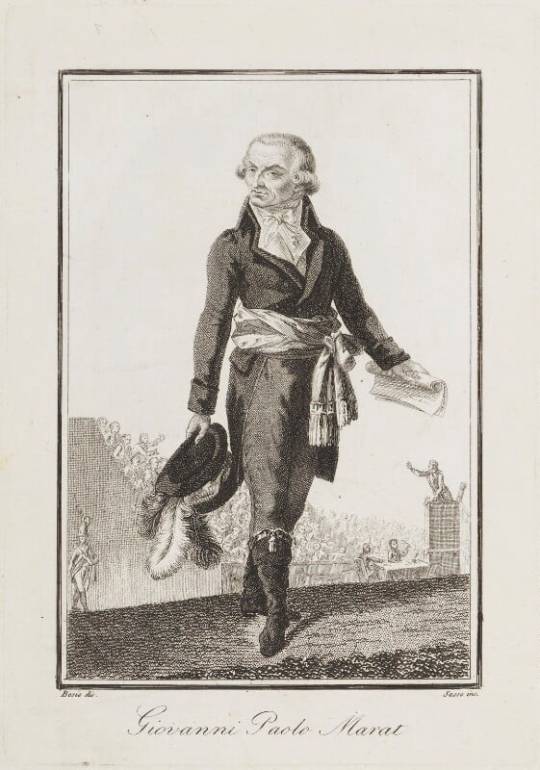
I've never seen Marat with a wig.
I was surprised because I had imagined (without any evidence) that he refused to wear a wig for political reasons. (I'm not sure how much of this picture is based on historical reality).
Since I learned about them, I've always wondered why Robespierre and Danton wore wigs while Marat, Camille, and Saint-Just did not. (Maybe they also wore wigs sometimes and just wanted to be painted without them in their portraits, but even if so, the choice is interesting).
And I would like to see Robespierre and Danton without their wigs (not before their executions). I guess Constance Charpentier (Danton's sister-in-law) would have left some sketches of him... (also without any proof)
86 notes
·
View notes
Text
Das Metropolitan Museum - New York
Autor: J. J. Rorimer, E. A. Standen Titel: Malerei der Welt - Das Metropolitan Museum in New York Verlag: DuMont Schauberg Erschienen: 1959 Sprache: Deutsch - El Greco - Werkstatt des Giotto - Piero di Cosimo - Andrea Mantegna - Robert Campin - Dirk Bouts - Hieronymus Bosch - Caravaggio - Rembrandt Harmensz van Rijn - Velasquez - Jusepe Ribera - Francesco Guardi - John Constable - Constance Marie Charpentier - Gustave Courbet - Pesellino - Giovanni di Paolo - Sassetta - Andrea del Verrocchio - Antonio Pollaiuolo - Carlo Crivelli - Fra Carnevale - Antonello da Messina - Vittore Carpaccio - Sandro Botticelli - Raffael - Hubert van Eyck - Rogier van der Weyden - Petrus Christus - Hugo van der Goes - Hans Memling - Joachim Patinir - Lucas Cranach der Ältere - Albrecht Dürer - Pieter Bruegel der Ältere - Hans Holbein der Jüngere - Bronzino - Tizian - Tintoretto - Veronese - Anton van Dyck - Edouard Manet - Claude Monet - Edgar Degas - Pierre Auguste Renoir - Paul Cezanne - Georges Seurat - Vincent van Gogh - Paul Gauguin - Peter Paul Rubens - Nicolas Poussin - Jacob Isaacksz Van Ruisdael - Meindert Hobbema - Jan Vermeer van Delft - Frans Hals - Francisco de Goya - Jean-Antoine Watteau - Francois Boucher - Jean Baptiste Simeon Chardin - Canaletto - Joshua Reynolds - Joseph Mallord William Turner - Thomas Lawrence - Jaques Louis David - Jean Auguste Dominique Ingres - Honore Daumier - Jean Baptiste Camille Corot Read the full article
#AlbrechtDürer#AndreadelVerrocchio#AndreaMantegna#AntonvanDyck#AntonellodaMessina#AntonioPollaiuolo#Bronzino#Canaletto#Caravaggio#CarloCrivelli#ClaudeMonet#ConstanceMarieCharpentier#DirkBouts#EdgarDegas#EdouardManet#ElGreco#FraCarnevale#FrancescoGuardi#FranciscodeGoya#FrancoisBoucher#FransHals#GeorgesSeurat#GiovannidiPaolo#GustaveCourbet#HansHolbeinderJüngere#HansMemling#HieronymusBosch#HonoreDaumier#HubertvanEyck#HugovanderGoes
0 notes
Photo
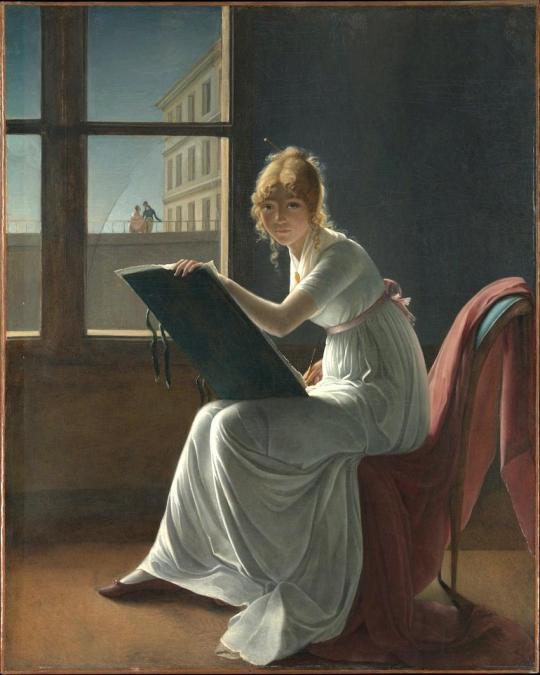
First attributed to Jacques-Louis David and then Constance Marie Charpentier, this compelling 1801 portrait is now believed to be the work of Marie-Denise Villers: https://publicdomainreview.org/collection/villers-portrait
107 notes
·
View notes
